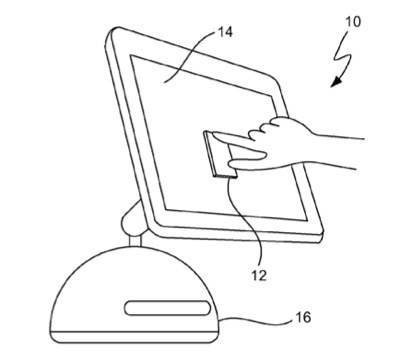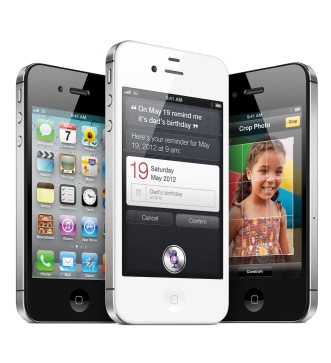An Apple patent (number 20010045627) at the US Patent & Trademark Office shows that Apple is at least considering touch screen displays on some Macs. The patent is for a shape detecting input device.
More particularly, the present invention relates to shape detection by an input device for a computer system. The patent involves a system and method for recognizing a signet and for performing an action associated with the signet, wherein the signet is an inanimate object. In one embodiment, the method includes generating a touch signal with a signet, the touch signal representing a particular signet pattern, recognizing the particular signet pattern, and performing an action associated with the particular signet pattern. The inventor is Peter Kennedy.
Here’s Apple’s background and summary of the invention: “There exist today many styles of input devices for performing operations in a computer system. The operations generally correspond to moving a cursor and/or making selections on a display screen. By way of example, the input devices may include buttons or keys, mice, trackballs, touch pads, joy sticks, touch screens and the like. Each of these devices has advantages and disadvantages that are taken into account when designing or configuring a computer system.
“Touch screens, in particular, are becoming increasingly popular because of their ease and versatility of operation as well as to their declining price. Touch screens allow a user to make selections and move a cursor by simply touching the display screen via a finger or stylus. For example, a user may make a selection by pointing directly to a graphical object displayed on the display screen. The graphical object may for example correspond to an on-screen button for performing specific actions in the computer system. In general, the touch screen recognizes the touch and position of the touch on the display screen and the computer system interprets the touch and thereafter performs an action based on the touch event. There are several types of touch screen technologies including resistive, capacitive, infrared and surface acoustic wave.
“Computer based systems utilizing touch screens have been used in many settings including retail, commercial, industrial, office, hospitality, education, and gaming environments, etc. By way of example, popular applications include information kiosks, automated teller machines (ATM), point of sale machines (POS), industrial machines, gaming machines, arcade machines, vending machines, airline e-ticket terminals, restaurant reservation terminals, customer service stations, library terminals, learning devices, etc.
“In environments utilizing POS machines, it is common practice to assign levels of authority to various individuals on the staff. For example, a sales clerk may be able to enter sales information but does not have the authority to make a refund. A supervisor is generally needed to execute a refund. The sales clerk and the supervisor may use the same POS terminal, but each of them will have a unique login code. Login codes are easily stolen or otherwise compromised. One well known solution to improve security is the use of physical keys. The owner of the physical key will know if it is stolen, whereas a stolen login code leaves no trace if stolen. Typically, physical keys are expensive and the terminals must be equipped with a locking mechanism that serve no function other than security.
“Similar situations can be found in industrial settings where process conditions are tightly controlled. For example, an operator may be able to operate industrial machine but does not have authority to make changes to any of the process parameters associated with the industrial machine. In cases such as these, a supervisor is needed to make a change.
“Similar situation may arise in work, libraries, and schools where computer terminals are shared by a number of different users. For example, a user may be able to use the computer terminal for general use but does not have the authority to make changes to the configuration of the computer or network to which it is attached. In cases such as these, a network administrator is needed to make changes.
“Thus, there is a need for improved techniques to implement different authorization levels or other tasks using touch screens
“The invention relates, in one embodiment, to a computer implemented method. The method includes generating a touch signal with a signet, the touch signal representing a particular signet pattern. The method also includes recognizing the particular signet pattern. The method further includes performing an action associated with the particular signet pattern.
“The invention relates, in another embodiment, to a computer system. The computer system includes a touch screen that generates signet data associated with a signet pattern when a signet having the signet pattern is placed on the touch screen. The computer system also includes a computer that recognizes the signet data and that initiates an action associated with the recognized signet data.
“The invention relates, in another embodiment, to a computer readable medium including at least computer code executable by a computer. The computer code includes storing shape data associated with one or more signets. The compute code also includes generating shape data based on contact with said touch sensitive device. The computer code further includes comparing the generated shape data to the stored shape data. The computer code additionally includes performing an action associated with the stored shape data when the generated shape data matches the stored shape data.
“The invention relates, in another embodiment, to a shape recognition method utilized in a computer based system having a touch sensitive device. The shape recognition method includes providing baseline signet signals. The shape recognition method also includes generating a current signet signal when a signet is placed on the touch sensitive device. The shape recognition method further includes comparing the current signal to at least one baseline signet signal. The shape recognition method additionally includes performing an action based on the current and baseline signet signals.
“The invention relates, in another embodiment, to a signet system. The signet system includes a touch sensitive area for receiving a signet having a signet pattern. The signet system also includes a detection system for generating a touch signal when the signet is presented to the touch sensitive area and for extracting shape data associated with the signet pattern from the touch signal.
“The invention relates, in another embodiment, to a computer implemented method. The method includes detecting contact with a touch screen. The method also includes generating shape information when contact is detected. The method further includes comparing the generated shape information with stored shape information. The method additionally includes determining a particular shape in contact with the touch screen based on the comparison. Moreover, the method includes initiating an action associated with the particular shape when it is determined that the particular shape is the particular shape in contact with the touch screen.”



